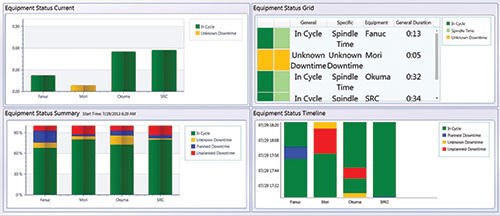Using Software to Support Your Automation Agenda
As shops look to streamline processes and increase productivity, automation is among the highest priorities. Software is one tool that can be easily implemented to help meet those goals.
A shop floor focuses on several aspects of automation when working with CNC machines, and software is one tool that can help manage the automation process. When investing in software, consider the entire problem you are attempting to solve.
A key factor in your software purchase should be integration. Many software vendors provide only one piece of a software solution, which makes it difficult to integrate with other software programs being used by the shop. By being able to purchase only what you need or what you are ready to integrate from a single provider, you gain tools that work together as a seamless package.
Scheduling also plays a critical role in optimizing automation. Job scheduling software should deliver and communicate in real time the orders that need to be manufactured, as well as track labor, material and delays. White boards and spreadsheets do not provide real-time data, so look for a solution that utilizes what-if scenarios, is designed for ease of use and receives buy-in from the operators using the product.
Leveraging a real-time machine monitoring system that ties directly into the machine tool can provide management with up-to-the-minute status reports as well as historical data. You can go one step further to bring automation together by having the machine data collection software communicate to the job scheduling software when machine downtime occurs, allowing the modification of your future job schedule. Management can improve machine productivity by reviewing data and measuring the results against uptime, downtime and profitability.
Many machine tool vendors are embracing technology that uses Ethernet for faster communication to the machine tool. Traditionally, mold builders have been limited to serial communication and direct numeric control (DNC) software for transferring NC programs. RS-232 communication speed is measured using baud rate (speed of transmission in number of characters per second). Most older machines communicate at 4,800 or 9,600 baud. Typically, mold and part complexities can take hours to transfer by a RS-232 serial connection at those baud rates. By leveraging Ethernet or network speeds, measured at a rate of millions of characters per second, the transfer is accomplished in minutes.
While some shops place a computer next to the machine to make this connection, DNC vendors are advocating the use of a server on the network to simultaneously communicate to machines, “streaming” the part program as they operate. Server use allows network administrators to manage, control and monitor the communications activity to the machines while enabling NC program backups for redundancy. They also can virtualize the computer environment with the DNC software should a disaster recovery be required.
Network-based machines can also be managed by one application to support Ethernet functionality and control, as well as to manage, track and document all transfer types from any form of communication to the machine. The key to earning more prospective Tier 1 and Tier 2 suppliers is to demonstrate that your facility has a program in place to support best practices and align the shop floor to the top floor.
To help with this, DNC software vendors have added features to track the data to text files, Microsoft Excel, HTML or databases such as Microsoft Access or SQL. Data includes the NC program revision control method, setup processes, quality documentation, drawings and real-time data capture. All of this ensures that the programs created, released and signed off on are the results of the parts created for the supplier.
The success of robust DNC communications, machine monitoring and specific jobs relies on shopfloor infrastructure and connectivity. Today, wireless and Ethernet hardware are available for machine tool integration of any brand or type. For years, serial RS-232 cabling was the only method for connecting the machine to allow for drip-feeding to the machine tool, which limited communication distance and reliability. By using Ethernet to serial adapters or wireless CNC adapters, users can often experience a fast communication speed to the machine, better reliability and greater flexibility. These solutions will provide IT departments with ease of management as well as an understanding of how to bridge the shop floor to the company network.
Summary
Manufacturers that are serious about streamlining processes and increasing productivity on the shop floor would be well advised to investigate the latest generation of solutions to help them attain both goals. Plenty of software options are available that can be tailored to specific applications by knowledgeable vendors.
Related Content
Questions and Considerations Before Sending Your Mold Out for Service
Communication is essential for proper polishing, hot runner manifold cleaning, mold repair, laser engraving and laser welding services.
Read MoreMachine Hammer Peening Automates Mold Polishing
A polishing automation solution eliminates hand work, accelerates milling operations and controls surface geometries.
Read MoreMMT Chats: 5 in 5 with Best Tool and Engineering
MoldMaking Technology Editorial Director Christina Fuges reveals 5 best practices for improving efficiencies within shops...in 5 minutes. Our guest is Joe Cherluck, President of Best Tool and Engineering in Clinton Township, Michigan. This episode is brought to you by ISCAR.
Read MoreConsiderations for Mold Base Material Selection
Choosing the right material can greatly affect the profitability and cost of your application.
Read MoreRead Next
How to Use Strategic Planning Tools, Data to Manage the Human Side of Business
Q&A with Marion Wells, MMT EAB member and founder of Human Asset Management.
Read MoreReasons to Use Fiber Lasers for Mold Cleaning
Fiber lasers offer a simplicity, speed, control and portability, minimizing mold cleaning risks.
Read MoreAre You a Moldmaker Considering 3D Printing? Consider the 3D Printing Workshop at NPE2024
Presentations will cover 3D printing for mold tooling, material innovation, product development, bridge production and full-scale, high-volume additive manufacturing.
Read More








.jpg;maxWidth=300;quality=90)




_300x250 3.png;maxWidth=300;quality=90)













